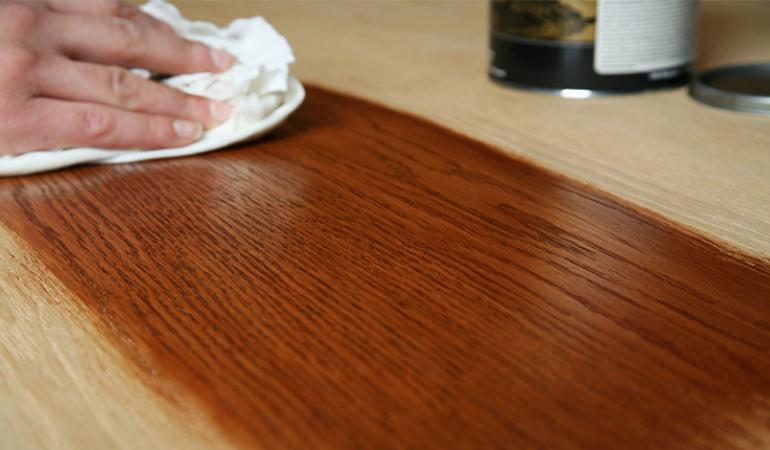In the world of woodworking, every craftsman aspires to achieve pristine finishes that accentuate the beauty of their creations. However, even the most skilled artisans can encounter the dreaded phenomenon of wood stain blotches, leaving otherwise flawless surfaces marred by unsightly imperfections. These blotches can be a source of frustration for both novice and experienced woodworkers alike.

Image: bestworkshop.co.uk
But fear not, for in this comprehensive guide, we will embark on a detailed exploration of wood stains and blotches, empowering you with the knowledge and techniques to conquer these obstacles and attain flawless finishes. Let us delve into the intricate realm of wood staining, uncovering the secrets to achieving seamless, even-toned surfaces.
Delving into the Realm of Wood Stains
Before we dive into the nitty-gritty of blotch prevention and removal, let us establish a firm understanding of wood stains and their transformative properties. Wood stains are essentially colored liquids that penetrate the surface of wood, enhancing its grain and altering its hue without fully obscuring the natural beauty of the wood.
These versatile liquids are available in an array of shades and finishes, enabling woodworkers to customize their projects according to their desired aesthetic. Oil-based stains are known for their excellent penetration and durability, while water-based stains offer ease of use and quick drying times. Gel stains, on the other hand, provide exceptional control and are ideal for creating intricate designs.
Understanding Wood Blotches: Genesis and Avoidance
With a firm grasp of wood stains, let us turn our attention to the enigmatic realm of wood blotches. These unsightly imperfections arise when certain areas of the wood absorb stain more readily than others, resulting in uneven coloring and blotchy patches. Understanding the underlying causes of blotching is paramount in developing effective prevention and removal strategies.
Wood density plays a crucial role in determining stain absorption. Variations in density, such as those found in softwoods like pine or fir, contribute to uneven staining and the formation of blotches. Additionally, the presence of natural oils and resins in certain wood species, such as mahogany or teak, can create barriers to uniform stain penetration, exacerbating blotching.
However, fear not, as there are proactive measures we can employ to minimize the risk of blotches. Sanding the wood thoroughly prior to staining ensures a smooth and even surface, promoting uniform absorption. Furthermore, applying a pre-stain conditioner can help regulate absorption, reducing the likelihood of blotching, particularly on porous woods.
Taming Unruly Blotches: Effective Removal Techniques
Trotz aller Vorsichtsmaßnahmen kann es dennoch vorkommen, dass sich auf der Oberfläche Ihrer kostbaren Holzarbeiten unerwünschte Flecken bilden. In solchen Fällen ist es unabdingbar, mit dem entsprechenden Wissen ausgestattet zu sein, um diese Makel mühelos zu beseitigen.
Schleifpapier in feiner Körnung (220 oder höher) ist eine bewährte Methode zur Entfernung von Flecken. Durch leichtes Schleifen der betroffenen Stellen wird die überschüssige Farbe abgetragen und eine gleichmäßigere Oberfläche geschaffen.
Alternativ können Sie einen chemischen Fleckenentferner verwenden, der speziell für die Beseitigung von Holzflecken entwickelt wurde. Tragen Sie den Entferner gemäß den Anweisungen des Herstellers auf und lassen Sie ihn einwirken. Anschließend wischen Sie die Oberfläche mit einem sauberen Tuch ab, um den Entferner und die entfernte Farbe zu entfernen.
Sollte der Fleck hartnäckiger Natur sein, kann auch eine Kombination aus Schleifen und chemischer Behandlung erforderlich sein. Schleifen Sie zunächst den Fleck leicht an und tragen Sie dann den Fleckenentferner auf. Lassen Sie ihn einwirken und wischen Sie ihn anschließend ab. Wiederholen Sie diesen Vorgang bei Bedarf, bis der Fleck vollständig entfernt ist.
![How to Fix Wood Stain Mistakes: Blotches, Spots [2024]](https://www.sawinery.net/wp-content/uploads/elementor/thumbs/wood-and-stain-qd4n8mn1z5vavs6umdisttdgg6whn365nrrqezqq2c.png)
Image: www.sawinery.net
Preventive Measures: Shielding Your Wood from Blotches
An ounce of prevention is worth a pound of cure, as the adage goes. By implementing a few simple preventive measures, you can significantly reduce the risk of blotches marring the surface of your woodworking projects.
-
Sanding: As mentioned earlier, thorough sanding is essential for creating a smooth and even surface that promotes uniform stain absorption.
-
Pre-stain conditioner: This magical potion helps regulate stain penetration, minimizing the risk of blotching on porous woods.
-
Test staining: Before applying stain to the entire surface, test it on an inconspicuous area to assess the wood’s absorption and identify any potential issues.
-
Thinning the stain: If the stain is too thick, it can result in uneven absorption and blotching. Thinning the stain with a solvent, such as mineral spirits, can improve penetration and reduce the risk of blotches.
-
Multiple thin coats: Instead of applying one thick coat of stain, opt for multiple thin coats. This allows each coat to penetrate evenly, reducing the likelihood of blotches.
-
Even application: Apply the stain evenly using a brush, roller, or rag. Avoid overworking the stain, as this can lead to uneven absorption.
-
Wiping off excess: After applying the stain, wipe off any excess immediately. This prevents the stain from pooling in certain areas, which can cause blotches.
How To Fix Wood Stain Blotches
Conclusion: Mastering the Art of Flawless Staining
In the realm of woodworking, the ability to achieve flawless finishes is a mark of true mastery. By understanding the intricacies of wood stains, identifying the causes of blotches, and implementing effective removal and preventive techniques, you can transform your woodworking projects into stunning masterpieces.
Remember, the journey to woodworking excellence is a continuous pursuit of knowledge and refinement. Embrace the challenges, experiment with different techniques, and never cease to seek perfection. With dedication and a touch of artistry, you will undoubtedly conquer the art of flawless staining, leaving behind a legacy of exquisite woodcraft that will stand the test of time.